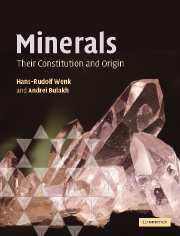Book contents
- Frontmatter
- Contents
- Preface
- Acknowledgments
- Figure credits
- Part I Structural features of minerals
- Part II Physical investigation of minerals
- Part III Variety of minerals and mineral-forming processes
- Part IV A systematic look at mineral groups
- 19 Important information about silica materials and feldspars
- 20 Simple compounds. Unusual mineral occurrences
- 21 Halides. Evaporite deposits
- 22 Carbonates and other minerals with triangular anion groups. Sedimentary origins
- 23 Phosphates, sulfates, and related minerals. Apatite as a biogenic mineral
- 24 Sulfides and related minerals. Hydrothermal processes
- 25 Oxides and hydroxides. Review of ionic crystals
- 26 Orthosilicates and ring silicates. Metamorphic mineral assemblages
- 27 Sheet silicates. Weathering of silicate rocks
- 28 Chain silicates. Discussion of some igneous and metamorphic processes
- 29 Framework silicates. Zeolites and ion exchange properties of minerals
- Part V Applied mineralogy
- Appendices
- Glossary
- References
- Index
- Plate section
- References
29 - Framework silicates. Zeolites and ion exchange properties of minerals
from Part IV - A systematic look at mineral groups
- Frontmatter
- Contents
- Preface
- Acknowledgments
- Figure credits
- Part I Structural features of minerals
- Part II Physical investigation of minerals
- Part III Variety of minerals and mineral-forming processes
- Part IV A systematic look at mineral groups
- 19 Important information about silica materials and feldspars
- 20 Simple compounds. Unusual mineral occurrences
- 21 Halides. Evaporite deposits
- 22 Carbonates and other minerals with triangular anion groups. Sedimentary origins
- 23 Phosphates, sulfates, and related minerals. Apatite as a biogenic mineral
- 24 Sulfides and related minerals. Hydrothermal processes
- 25 Oxides and hydroxides. Review of ionic crystals
- 26 Orthosilicates and ring silicates. Metamorphic mineral assemblages
- 27 Sheet silicates. Weathering of silicate rocks
- 28 Chain silicates. Discussion of some igneous and metamorphic processes
- 29 Framework silicates. Zeolites and ion exchange properties of minerals
- Part V Applied mineralogy
- Appendices
- Glossary
- References
- Index
- Plate section
- References
Summary
The framework structure
Framework silicates contain a three-dimensional framework of tetrahedra, in which all oxygen atoms are bonded to two tetrahedral cations, resulting in a general formula with a T:O ratio 1:2. Tetrahedral ions can be silicon or aluminum with Al3+ ≤ Si4+. Quartz, SiO2, is an example with no aluminum, while anorthite (CaSi2Al2O8) is an example where aluminum and silicon are equal. The aluminum-containing framework silicates are referred to as alumosilicates with all aluminum atoms tetrahedral, contrary to the alumosilicates discussed in Chapter 26, where at least some aluminum is octahedral. The composition of framework silicates is quite simple compared to pyroxenes and amphiboles: the major cations are silicon and aluminum; in addition, large cavities in the framework may contain cations (e.g., K+, Na+, Ca2 +, Ba2 +, Sr2 +) as well as anions and anion groups (e.g., Cl-, CO2-3, SO2-4, NH+4 and H2O molecules). This is illustrated for scapolite in Figure 29.1. There are no octahedral building units that are an important part of all other silicate structures and therefore framework silicates do not contain octahedral cations (e.g., Mg2+, Fe2+). Among framework silicates, feldspars are most relevant and they have already been discussed in Chapter 19. (We will review some aspects of feldspar structures in this chapter.) Feldspathoids (e.g., nepheline, leucite) are a related group of anhydrous framework silicates, the main difference being that they are deficient in SiO2, and the structure needs to be able to accommodate more large alkali cations than do the alkali feldspars.
- Type
- Chapter
- Information
- MineralsTheir Constitution and Origin, pp. 496 - 508Publisher: Cambridge University PressPrint publication year: 2004



